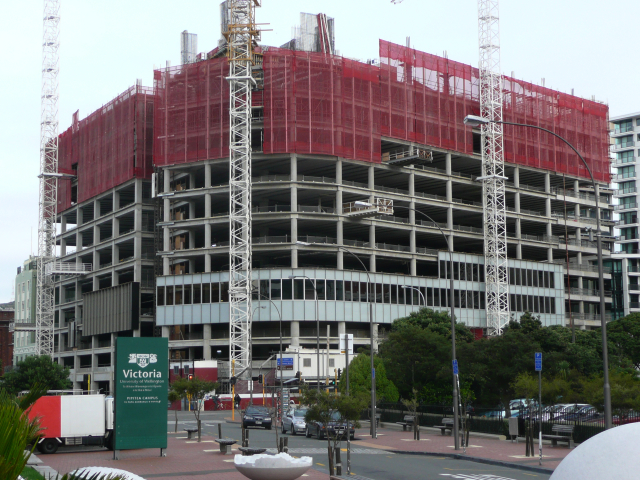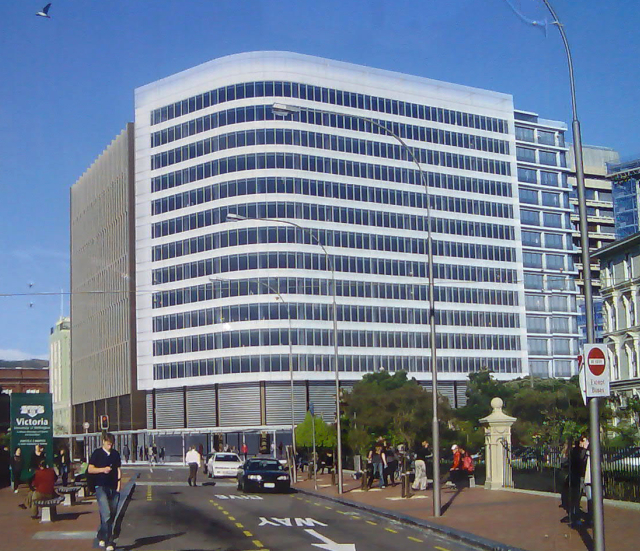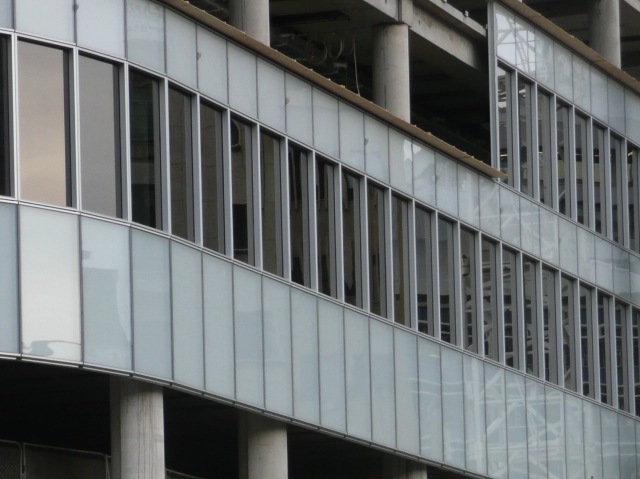Indeed, you’re all too fast to catch me out – it shows we have some pretty sharp eyes here in the capital at picking out window details. OK, it wasn’t that hard a competition, and it is a pretty big building that we’ve all been watching with eagle eyes, and despite what I said before, its not really something that can be ignored.

Yes, the building is the Mark Dunajtschik development at number 1 Featherston Street, with the main tenant going to be the Taxman. It’s big, but nowhere near as big as the Pentagon (Mobsta, tell your source they’re sadly mistaken). To put it into some kind of perspective, this building is about 70m long, whereas each wall of the Pentagon is 280m long. And this building has – at my best guess, somewhere between 2000m2 to 3000m2 per floor, whereas the Pentagon has 116,000m2 per floor ie so the big P is about 40-50 times the size in area: although of course only half as tall. But let’s not quibble about numbers – it still will have the biggest floorplates in Wellington, and that excites a certain kind of bureaucrat who likes to see all his or her staff sitting out in front of them.

Starkive’s comment that:
Lubyanka comparisons notwithstanding – Wellington is surely big enough and capitoline enough to live up to an imposing pile of reinforced concrete and glass across from its railway station. We don’t need a city made up solely of gracefully articulated apartment balconies. All that pav and no potatoes?
and Jason’s comment that:
I think I hate it. I think I love it. It’s a big full stop at the end of the city – the weighty terminator of a fifteen clause sentence about accountability. It’s big and solid and grey. What better symbol for tax bureaucracy?
shows that we’re in a love hate relationship with something of this size. Yes, it IS a very nice shade of grey – inoffensive, non-coloured, background that won’t obtrude, made up of thousands of tiny dots of white, and I’m still hoping for some more external articulation so its not so totally blank.

Personally, for me: its just too big, and just too blocky to be anything other than a blot on the city, especially poised where it is opposite the front door of the Railway Station. I don’t know how it got past the watchful eyes of the Council’s Urban Design team, who will normally pounce on anything that looks tedious and rip it apart with their bare hands until the blood starts streaming from the eyes of the Architects concerned – but here, big and boring and bland seems to be quite the acceptable thing.

It’s the Crimson Permanent Assurance sailing forth on the high accountant-seas. It is a Juggernaut, a Behemoth of the greatest order, and its amusing that apparently the Tax department does not want to buy the naming rights – they really don’t want to remind us that we work till around this time of the year just for them, and its only after April / May that we get to take home some play money. Indeed, Starkive’s further comment that:
I can see this building and its future population of tax gatherers providing a very satisfying focus for national resentment – a kind of lightning rod for neo-liberals and Friedmanites.
really says it all. They’re hoping that we will forget – and most of the Macca-munching ground floor occupants probably will – the good burghers of bad-burger-land (sorry, couldn’t resist it) will munch away happily, immune to the tapping of calculators, and shuffling of papers up above them. Of course, yes, I know, the IRD probably don’t even have calculators any more, it all just goes into a vast machine humming with electricity, and each week there’s a hole in your pay-pocket. But the point is: the rest of us won’t forget. So if there is to be no name, how about at least a nice slogan or two?
I’ll refrain from further comment, and just leave you with some pictures, just for Callum. There seems no better time than to quote Mr Orwell, on the men from the Government:
The Ministry of Truth — Minitrue, in Newspeak — was startlingly different from any other object in sight. It was an enormous pyramidal structure of glittering white concrete, soaring up, terrace after terrace, 300 metres into the air. From where Winston stood it was just possible to read, picked out on its white face in elegant lettering, the three slogans of the Party:
WAR IS PEACE
FREEDOM IS SLAVERY
IGNORANCE IS STRENGTH
The Ministry of Truth contained, it was said, three thousand rooms above ground level, and corresponding ramifications below. Scattered about London there were just three other buildings of similar appearance and size. So completely did they dwarf the surrounding architecture that from the roof of Victory Mansions you could see all four of them simultaneously. They were the homes of the four Ministries between which the entire apparatus of government was divided.
The Ministry of Truth, which concerned itself with news, entertainment, education, and the fine arts.
The Ministry of Peace, which concerned itself with war.
The Ministry of Love, which maintained law and order.
And the Ministry of Plenty, which was responsible for economic affairs.
Their names, in Newspeak: Minitrue, Minipax, Miniluv, and Miniplenty.
The Ministry of Love was the really frightening one. There were no windows in it at all. Winston had never been inside the Ministry of Love, nor within half a kilometre of it. It was a place impossible to enter except on official business, and then only by penetrating through a maze of barbed-wire entanglements, steel doors, and hidden machine-gun nests. Even the streets leading up to its outer barriers were roamed by gorilla-faced guards in black uniforms, armed with jointed truncheons.





maximus- now you’ve done it… you had to make it a political commentary about the requirement of paying taxes in a contemporary society, and as far leftist socialist my feathers start to get ruffled. (I’m apparently an irritably marxist bird.)
The tax day argument has always irritated me (the one about working until april before any of the money you get is yours.) It leaves the illusion that the remaining 8 months is somehow left for whimsical and free spirited spending when (at least in my life) about 7.5 months are left working to pay for other junk that is equally inflexible, required, and generally unfun. 4 months of our lives are spent working just to afford a roof over our heads. So four months pay for health care, fire, police protection, education, parks and recreation, etc, etc seems like a relatively good deal to me.
Despite all of the wanna-be John Galt fantasies, my hunch is that without the oh so oppressive structure which we work 4 months to support, that most of us wouldn’t make it through one month. So 8 months seems like a pretty good deal to me.
And my personal experience is that the people I have encountered who complain the most about their taxes are the ones who are the least active in their communities, or active politically. So not only are they unwilling to contribute to providing a non-governmental approach to societal problems, but they are also not willing to engage civically to address any of the problems.
Putting aside the political discussion now, from a design discussion, I can imagine that designing the building for the taxman to be a difficult assignment. Any attempt to celebrate the role that taxes have in providing for our society brings up exactly the orwellian qualities that you describe, not to mention the protestations of fiscal irresponsibility; a stripped and economical box describes the worst of bureaucratic emptiness. Of course in this age most of our government offices are in developer driven buildings which personally I believe has the absolute worst symbolism about the role of government that there could be, that ultimately our mutual agreement to governance by democratically elected peers, is completely controlled by a corporate state.
Who is John Galt?
Of course, in these days of Google driven information, there’s almost no point in asking any questions: one simply has to ask the nice boys and girls in the googleplex and voila: the Wikipedia replies –
“John Galt is a fictional character in Ayn Rand’s novel Atlas Shrugged. Although he is absent from much of the text, he is the subject of the novel’s oft repeated question, “Who is John Galt?”, and the quest to discover the answer. As the plot unfolds, Galt is acknowledged to be a creator and inventor who embodies the power of the individual. He serves as a counterpoint to the social and economic structure depicted in the novel. The depiction portrays a society based on oppressive bureaucratic functionaries and a culture that embraces the stifling mediocrity and egalitarianism of socialistic idealism. He is a metaphorical Atlas of Greek mythology, holding up the world.”
All very well and good, but i was talking more about the building than the whole tax regime. Still, I’m doing my bit to engage civically to address societal problems with our architecture. I’m wondering – is this building bland, because it is for the tax man; or did the taxman want it because it was bland? I don’t know of people actively celebrating their paying tax – not many, if any – indeed there is a massive row going on in England about this very subject, with the top rate being raised to 60% i think, and lots of rich old farts threatening to leave the country because of it. I’d imagine we’d be happy to have the rich old farts here, and only tax them at 39% – what a lovely offer.
I recognise I buried it at the end of the political diatribe, but my final paragraph I think illustrates some of the inherent problems. Too nice of a building, the public will complain about financial irresponsibility, or the attempt to falsely rebrand the department as a “nice, attractive” agency.
Here’s the US IRS headquarters outside DC for comparison.
http://www.cagley.com/Government/government2.htm
Um…
The Pentagon statement was a quip… a joke.
The Pentagon Building has the largest floor area in the world… nothing in Wellington is going to compare to that.
It was a comment on people saying “IT”S GOT THE LARGEST FLOOR AREA IN WELLINGTON!” (as if that was some claim to fame).
“I’m wondering – is this building bland, because it is for the tax man; or did the taxman want it because it was bland?”
If anything it will be the latter (But I doubt aesthetics had anything to do with it).
The building was designed and the site was being cleared before the IRD even signed up.
There were a number of organisations interested in taking space in the building, including ANZ, MFAT (amongst others, however IRD won out because they wanted the most space….)
Apparently (according to a couple of designers that I have spoken to) it is a bit of a bugger to plan inside – column spacings and mullion spacings and core location and all that). It’s proving to be a bit of a handful.
I don’t think that there’s any excuse for that – WAM have an Interiors team, surely they could have been consulted about an effective way to plan a space – although it could have something to do with IRD requirements…
Nice John Galt reference BTW.
Less obvious that a Howard Roark one…..
sorry mobsta-
I cringe when I hear people repeat incorrect facts (like when I heard a colleague proclaim that Australia was larger than North America). Was just trying to keep a misnomer from being spread.
” I don’t know how it got past the watchful eyes of the Council’s Urban Design team, who will normally pounce on anything that looks tedious and rip it apart with their bare hands until the blood starts streaming from the eyes of the Architects concerned – but here, big and boring and bland seems to be quite the acceptable thing. ”
This would have been before Plan Change 48, when a building within the height limit would have been a Controlled Activity, rather than Discretionary (Restricted) as it is now. In other words, the urban designers could argue for changes and impose conditions up to a point, but council couldn’t actually refuse consent on the trivial grounds of it being butt ugly. Nowadays, the blood can start streaming :-)
Mobsta – a quip? A QUIP ?! Have you any idea how long I spent on the Pentagon website last night converting feet to metres and acres to sq metres ? Hrumphf
I was just looking at some additional photos of the IRS building outside washington dc – check out this aerial photo.
http://4.bp.blogspot.com/_X7igbyFfqhw/SFZOjJUrjxI/AAAAAAAAAYU/AX-SgQ4tRiY/s400/IRS+AERIAL.jpeg
There is a metro line that runs diagonally across the lower right hand of the photo. How strange is it that the building wraps around the residential neighbourhood and that the centre of the whole development diagram is one of those individual houses. Talk about feeling unfairly ruled out by the government tax man. It’s hard to tell exactly where the centre of the circle is exactly, it probably is the centre of the street intersection – still strange.
The parking lot/garage sector (the upper part of the complex, looks like a funnel leading into the street – or perhaps a vacuum sucking the money from the public (for those who want to see such imagery?…)
Maximus – I hope you didn’t spend TOO long on the Pentagon website….
I understand they don’t really like it.
You will be getting a knock on your door in 5…. 4…. 3…..
Mobsta. Thanks for the info re MFAT etc. I didn’t know that. And good job winding up Maximus. Gotta make them check those figures! My suspicions on the layout of columns within: the carparks. They tend to have a fairly rigorous effect on layout and from the promo pic it looks as though at least the whole first floor is given over to Parking.
I would have thought that only a few (policy) IRD jobs would have needed to be located in close proximity to the rest of government. Most of the rest would be process related. So why do they need to be located just a few hundred meters from Parliament?
Wellington commercial real estate prices are amongst the highest in the country. If IRD had distributed their operations in to a few provincial cities, then they’d support jobs outside of the capital, make a couple couple of NZ’s smaller cities more interesting and viable, and lowered the cost of collecting tax.
Good question Mr D P. The IRD used to have provincial offices in smaller cities, but these appear to have been closed down now. Certainly Dave Henderson has kicked them out of his building in Christchurch!
Can anybody tell us whether they still do have them, or have they indeed concentrated every single job in Wellington, on prime land by the Railway Station?